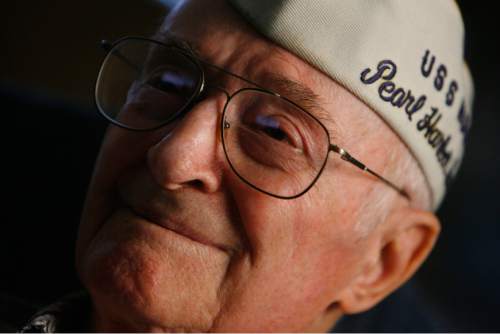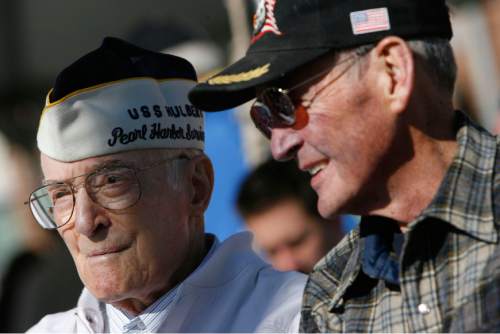This is an archived article that was published on sltrib.com in 2015, and information in the article may be outdated. It is provided only for personal research purposes and may not be reprinted.
Marion Kesler, a cook's helper who warned his shipmates that the Japanese were attacking Pearl Harbor then loaded cartridges into a machine gun belt as the USS Hulbert tried to fend the attackers, died Friday at his home in Taylorsville. He was 95.
Kesler's son, Kenneth Kesler, a physician, said his father died of causes incident to age. The elder Kesler's wife, the former Viola Leavitt, died Feb. 17.
Kesler was one of seven Utahns known to be survivors of the Pearl Harbor attacks honored at the state Capitol in a 2011 ceremony to commemorate the 70th anniversary of the attack. At least three of the men remain alive.
Kesler was 22 years old and had been in the Navy about four months when Dec. 7, 1941, arrived. The Hulbert was a destroyer built at the end of World War I and converted to maintain amphibious patrol-bomber planes known as Catalina flying boats.
As a cook's helper, Kesler's job mostly entailed taking food from the galley to the 125 or so men in the quarters below.
He was standing on the Hulbert's deck, talking with the cook, Wally Martenson, when they heard and saw planes "coming in out of the sun," Kesler recalled in a 2011 interview with The Tribune.
"We saw this one plane, it was so close to us, we could see the pilot in the front," Kesler said in a 2010 interview with the radio program "Hometown Heroes."
Martenson recognized the red disk painted on the planes and knew the Japanese were attacking.
Kesler ran below deck to tell the crew. The ship's alarm didn't work.
"They said, 'You're crazy. Go get us more hash browns and eggs,' " Kesler recalled.
Then the Hulbert's machine guns began firing.
Martenson manned a .50-caliber machine gun and shot down a Japanese bomber. Kesler later supplied the verification that Martenson was the first to shoot down a Japanese plane that morning.
Kesler spent the rest of that morning's attack loading .50-caliber cartridges into a belt that was then fed into a machine gun. Not only was it the first time Kesler had worked with bullets, he didn't even know there were .50-calibers on top of the galley.
As the battle continued, Kesler could see a fireball coming from the USS Arizona on the other side of the bay. He also saw the USS Oklahoma capsize. One of the Hulbert's motor boats was taken to gather dead out of the water.
Marion Ray Kesler was born Sept. 21, 1919, in Parowan to Albert Kesler and Myrtle Idona Lee, the fourth of their nine chhildren. Albert Kesler was a miner. The family later moved to Delta then Tooele.
Kesler was a member of the Civilian Conservation Corp in 1938. To avoid being drafted into the Army, he signed a six-year enlistment with the Navy in August of 1941.
After Pearl Harbor, Kesler remained aboard the Hulbert. The ship was later ordered to the Aleutian Islands and participated in the battle there. Other than the two hours or so Kesler spent helping load a machine gun at Pearl Harbor, Kesler spent World War II as a cook and cook's helper.
Kesler was on leave visiting family when he met Leavitt on a train traveling from Delta to Tooele, Kenneth Kesler said. They married Sept. 10, 1944, in Los Angeles. The young wife placed the control panels on aircraft being manufactured in San Diego, her son said.
After Japan surrendered, the Navy sent Hulbert back to Pearl Harbor. The Navy discharged him Dec. 22, 1946, with the rank of chief commissary steward. Kesler and his wife settled in Salt Lake City.
Kesler went to work as a welder for Kennecott Copper Corporation. He retired in 1982.
As the decades passed, Kesler gradually began talking to his wife and family about his war experiences. Kenneth Kesler said he was at the Utah State Fair in the late 1980s when he saw an exhibit for the Pearl Harbor Survivors Association. He encouraged his father to join, and the elder Kesler became active in the organization.
Kesler made his first trip back to Pearl Harbor in 1990. He made at least two more visits there in later years, including a visit on the attack's 69th anniversary.
"When kids talked with him, he became really animated and talked with them about his experiences," Kenneth Kesler said Tuesday.
Besides his son, Kesler's survivors include his brothers Veryl and Calvin Kesler; daughter Linda Caywood; seven grandchildren and 11 great-grandchildren.
In his 2010 radio interview, Kesler offered a simple answer to the question of whether he hated the Japanese.
"I'm right now driving a Toyota," he said.
Twitter: @natecarlisle







